CFD

The approaches of Computational Fluid Dynamics (CFD) have been developing very fast within the recent decades. Now CFD as a tool is used in many areas, for example, see the list of the projects below.
Note the CFD surgery session provided by Dr Xie.
For queries about this topic, contact Zheng-Tong Xie.
View the calendar of events relating to this topic.
Projects

A step toward establishing minimum requirement for CFD modelling of dispersion from floating roof tanks
Zheng-Tong Xie, Ian Castro (Investigators)
It is of great importance to estimate an emission flux (due to leaking from an oil tank) from near field wake, which requires a better understanding of vortex shedding from the tank, in particularly in how the low frequency motion behaves. Large-eddy simulation approaches embedded in up-to-date CFD package will be used for this purpose. This project has a strong link with Concawe and U Surrey.

Advanced modelling for two-phase reacting flow
Edward Richardson (Investigator)
Engine designers want computer programs to help them invent ways to use less fuel and produce less pollution. This research aims to provide an accurate and practical model for the injection and combustion of liquid fuel blends.

Advanced simulation tools for prediction of flash-back in hydrogen-rich gas turbine combustion
Edward Richardson (Investigator), James Bailey
The project involves the numerical simulation of hydrogen-rich flows using Direct Numerical Simulation (DNS) and Large Eddy simulations. Hydrogen rich fuels offer the opportunity to reduce the carbon intensity of energy supply. Hydrogen-rich fuels and other low-carbon energy sources are expect to become increasingly important in this regard. Hydrogen is more reactive and diffusive than conventional hydrocarbon fuels requiring advanced computational methods to optimise the use of these fuels in gas turbines.
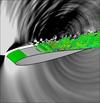
Aerofoil noise
Richard Sandberg (Investigator)
High-performance computing is used to identify noise sources on aerofoils.

Assessment of the performance of novel RANS and hybrid turbulence models on the flow around a cylinder
Manuel Diaz Brito
The turbulent flow around a circular cylinder is a widely studied problem in fluid dynamics. At a certain characteristic Reynolds numbers the development of a turbulent wake occurs simultaneously with separation of the laminar boundary layer. The mechanisms defining this critical flow state are very complex to predict computationally. In this project the suitability of novel non-linear eddy viscosity closures and a hybrid Flow Simulation Methodology formulation to face these massively separated flows is studied. The flow predicting capabilities of the baseline EASM, ?-?-EASM and FSM-?-?-EASM tested are contrasted with the industrial renowned k-?-SST turbulence model. In the visualisation of the results it is evident that the ?-?-EASM has greater flexibility estimating the components of the Reynolds stresses with respect to the baseline EASM and the k-?-SST. Although dome differences are observed, the prediction of the critical flow around a cylinder is not accurately achieved by any of these RANS models, but the FSM-?-?-EASM shows great resemblance with the validation data, demonstrating capabilities of resolving very complex flow phenomena with minimum user input if the computational grid is fine enough. In order to demonstrate even greater advantages of non-linear models it was postulated that the addition of a streamwise impinging vortex hitting the leading edge of the cylinder would make the flow field fully three-dimensional. First attempts were tried in this route but time constraints limited the ultimate scope of the present work.

Centre for Doctoral Training in Next Generation Computational Modelling
Hans Fangohr, Ian Hawke, Peter Horak (Investigators), Susanne Ufermann Fangohr, Thorsten Wittemeier, Kieran Selvon, Alvaro Perez-Diaz, David Lusher, Ashley Setter, Emanuele Zappia, Hossam Ragheb, Ryan Pepper, Stephen Gow, Jan Kamenik, Paul Chambers, Robert Entwistle, Rory Brown, Joshua Greenhalgh, James Harrison, Jonathon Waters, Ioannis Begleris, Craig Rafter
The £10million Centre for Doctoral Training was launched in November 2013 and is jointly funded by EPSRC, the University of Southampton, and its partners.
The NGCM brings together world-class simulation modelling research activities from across the University of Southampton and hosts a 4-year doctoral training programme that is the first of its kind in the UK.

CFD for urban environments
Zheng-Tong Xie, Ian Castro (Investigators), Venkata Boppana
As part of the NERC’s National Centre for Atmospheric Science, we are continuing on the modeling of wind flows around buildings and through streets, and the consequent dispersion of pollutants and heat transfer.
In collaboration with CD-adapco, one of the ‘big three’ CFD code vendors.

Complexity in Modelling Electric Marine Propulsive Devices
Suleiman Sharkh, Neil Bressloff, Hans Fangohr (Investigators), Aleksander Dubas
This project involves the simulation of turbulent flow around a marine rim-driven thruster and the complex interaction of flow features involved through computational fluid dynamics. Following this, the optimisation of design parameters using computational fluid dynamics to calculate the objective function is performed and surrogate modelling utilised to estimate optimum design configuration.

Computational Fluid Dynamics of Compressor Blades Within a Gas Turbine Engine (HiPSTAR)
Richard Sandberg (Investigator), John Leggett
As modern engines become more and more efficient, the importance of understanding the finer details of the physics involved grows, if further gains are to be achieved. In such harsh enviroments, such as within a gas turbine engine, there are few means of studying them physicaly and we are left with little choice but to use super computers to model the flow.

Coupled Fluid-Structure Interaction to model Three-Dimensional Dynamic Behaviour of Ships in Waves
Pandeli Temarel, Zhi-Min Chen (Investigators), Puram Lakshmynarayanana
In the present study we focus our attention on fluid-structure interactions (FSI) of flexible marine structures in waves by coupling a fluid solver using Computational Fluid Dynamics (CFD) and a structural solver using Finite Element Analysis (FEA) software.
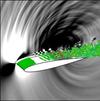
Coupled multi-scale simulation of high Reynolds number airfoil flows
Neil Sandham, Nicola De Tullio (Investigators), David Lusher
Application of multi-scale nested direct numerical simulations to high Reynolds number aerofoil flows.
Design of Forward Fins on Starship
Investigating the design of SpaceX's Starship concept and as to why that design was selected.

Development of a novel Navier-Stokes solver (HiPSTAR)
Richard Sandberg (Investigator)
Development of a highly efficient Navier-Stokes solver for HPC.

Diffusion at solute/solvent interfaces
Anatoliy Vorobev (Investigator), Ruilin Xie
We aim to develop the theoretical model that would provide an accurate description for the mixing process of two miscible liquids, and, in particular, would reproduce our experimental optical observations. The model based on the phase-field (Cahn-Hilliard) approach is adopted for the mixture of two miscible liquids. The model takes into account the surface tension effects, the non-Fickian diffusion across the liquid/liquid interface, and hydrodynamic flows that might be generated near the interface by the concentration gradients.

DIPLOS - Dispersion of Localised Releases in a Street Network
Trevor Thomas, Ian Castro (Investigators)
The security threat level from international terrorism, introduced by the UK Security Service, has been classified as either "severe" or "critical" for much of its six-year history, and currently remains as "substantial" (source: MI5 website). Part of the risk posed by terrorist threats involves potential releases of air-borne chemical, biological, radiological or nuclear (CBRN) material into highly populated urbanised areas. Smoke from industrial accidents within or in the vicinity of urban areas also pose risks to health and can cause widespread disruption to businesses, public services and residents. The Buncefield depot fire of 2005 resulted in the evacuation of hundreds of homes and closure of more than 200 schools and public buildings for two days; consequences would have been much more severe if prevailing meteorological conditions had promoted mixing or entrainment of the smoke plume into the urban canopy. In both these scenarios it is crucial to be able to model, quickly and reliably, dispersion from localised sources through an urban street network in the short range, where the threat to human health is greatest. However, this is precisely where current operational models are least reliable because our understanding and ability to model short-range dispersion processes is limited. The contribution that DIPLOS will make is:
1. to fill in the gaps in fundamental knowledge and understanding of key dispersion processes,
2. to enable these processes to be parametrized for use in operational models,
3. to implement them into an operational model, evaluate the improvement and apply the model to a case study in central London
Most of the existing research on urban dispersion has focused on air quality aspects, with sources being extensive and distributed in space. Scientifically, this research is novel in focusing on localized releases within urban areas, and on dispersion processes at short range. Through a combination of fundamental studies using wind tunnel experiments and high resolution supercomputer simulations, extensive data analysis and development of theoretical and numerical models, DIPLOS will contribute to addressing this difficult and important problem from both a scientific research and a practical, operational perspective.

Direct Numerical Simulations of transsonic turbine tip gap flow
Richard Sandberg (Investigator)
Direct Numerical Simulations are conducted of the transsonic flow through the tip gap at real engine conditions.

Dispersion of Small Inertial Particles in Characteristic Atmospheric Boundary Layer Flows
Zheng-Tong Xie (Investigator), Thorsten Wittemeier
This project aims at improving the near-field accuracy of short term predictions of the dispersion of particulate matter in the atmospheric boundary layer. For this purpose a variety of LES and DNS modelling approaches is used.

Eddy-resol?ving Simulation?s for Turbomachi?nery Applicatio?ns
Richard Sandberg (Investigator), Li-Wei Chen
Traditionally, the design of turbomachinery components has been exclusively accomplished with steady CFD, with Reynolds Averaged Navier-Stokes (RANS) models being the predominant choice. With computing power continuously increasing, high-fidelity numerical simulations of turbomachinery components are now becoming a valuable research tool for validating the design process and continued development of design tool.
In the current project, Direct Numerical Simulations (DNS) and other eddy-resolving approaches will be performed of turbomachinery components to establish benchmark data for design tools, and to investigate physical mechanisms that cannot be captured by traditional CFD approaches.
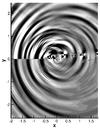
Effects of trailing edge elasticity on trailing edge noise
Richard Sandberg (Investigator), Stefan C. Schlanderer
This work considers the effect of trailing edge elasticity on the acoustic and hydrodynamic field of a trailing edge flow. To that end direct numerical simulations that are fully coupled to a structural solver are conducted.

Evaluation of Vortex Shedding effects on Slender Structures using Large-Eddy Simulation
Zheng-Tong Xie, Ian Castro (Investigators), Steven Daniels
Wind-induced vortex shedding on buildings is a main concern for the engineer, as this can lead to severe structural failures, or at the very least fatigue concerns. Wind tunnel testing of this effect is somewhat limited with the generation of turbulent flow, making the use of numerical techniques more appealing. Using Iridis3&4, Computational Fluid Dynamics has been employed to simulate the turbulent wind flow around tall buildings and bridge decks. The research proposes novel numerical techniques for the analysis of vortex induced effects on these structures for an effective use in industry.

Flow and sedimentation processes in submarine meandering channels
Stephen Darby (Investigator)
The overall aim of this project is to generate a step-change in our understanding of the interactions between flow,
morphology & sedimentology within an active submarine channel fed by saline density currents. This central aim will be addressed through a combination of field measurements and innovative numerical modelling of gravity current morphodynamics

Fluid Dynamics Optimisation of Rim-Drive Thrusters and Ducted Hydrokinetic Generators
Aleksander Dubas, Suleiman Sharkh (Investigators)
This is a Knowledge Transfer Partnership project is a collaboration between the University of Southampton and TSL Technology Ltd. to develop computational fluid dynamics software design tools for modelling and optimising the design of propeller thrusters and water turbine generators.

Fluid Loads and Motions of Damaged Ships
Dominic Hudson, Ming-yi Tan (Investigators), Christian Wood, James Underwood, Adam Sobey
An area of research currently of interest in the marine industry is the effect of damage on ship structures. Research into the behaviour of damaged ships began in the mid nineties as a result of Ro-Ro disasters (e.g. Estonia in 1994). Due to the way the Estonia sank early research mainly focused on transient behaviour immediately after the damage takes place, the prediction of capsize, and of large lateral motions. Further research efforts, headed by the UK MoD, began following an incident where HMS Nottingham ran aground tearing a 50m hole from bow to bridge, flooding five compartments and almost causing the ship to sink just off Lord Howe Island in 2002. This project intends to answer the following questions:
“For a given amount of underwater damage (e.g. collision or torpedo/mine hit), what will be the progressive damage spread if the ship travels at ‘x’ knots? OR for a given amount of underwater damage, what is the maximum speed at which the ship can travel without causing additional damage?”

Fluid Structure Interactions of Yacht Sails
Stephen Turnock (Investigator), Daniele Trimarchi
The research is the main subject of the PhD topic. It regards the application of fluid structure interaction techniques to the domain of yacht sails simulation

High-resolution shock-capturing (HRSC) methods for elastic matter in general relativity
Carsten Gundlach, Ian Hawke, Stephanie Erickson (Investigators)
We are designing HRSC methods for numerical simulation of elastic matter coupled to general relativity and later magnetic fields, with the ultimate aim of simulating old neutron stars, which have elastic crusts.

Hybrid RANS/LES methods
Richard Sandberg (Investigator), Markus Weinmann
Novel hybrid RANS/LES methods are developed for more accurate and efficient simulation of flow over complex geometries.
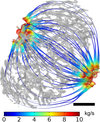
Image Based Modelling of Fluid Flow through Lymph Nodes
Tiina Roose, Bharathram Ganapathisubramani, Geraldine Clough (Investigators), Laura Cooper
In this project we are using images of mouse lymph nodes to investigate the fluid transport pathways through it. The images of the nodes are taken using selective plane illumination microscopy, and synchrotron micro computed tomography. The fluid flow is modelled using Darcy's law in COMSOL Multiphysics and the models are run on the Iridis cluster.
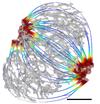
Investigations of Lymphatic Fluid Flow
Tiina Roose, Bharathram Ganapathisubramani, Geraldine Clough (Investigators), Laura Cooper
The lymphatic system performs three main roles returns interstitial fluid back into the blood stream to maintain tissue fluid homeostasis. The aim of this project is to increase our understanding of how the lymph flows through the system by creating three dimensional fluid structure interaction models of the secondary lymphatic valves and image based models of lymph nodes.

Is fine-scale turbulence universal?
Richard Sandberg (Investigator), Patrick Bechlars
Complementary numerical simulations and experiments of various canonical flows will try to answer the question whether fine-scale turbulence is universal.

Jet noise
Richard Sandberg (Investigator), Neil Sandham
Direct numerical simulations are used to investigate jet noise.

Laminar to Turbulent Transition in Hypersonic Flows
Neil Sandham, Heinrich Luedeke
Understanding of laminar to turbulent transition in hypersonic boundary-layer flows is crucial for re-entry vehicle design and optimization. The boundary-layer state directly affects the temperatures on the vehicle surface and its viscous drag. Therefore transition has to be considered to correctly compensate for drag and to properly design the thermal protection system.
For the proposed study, in order to obtain a clear understanding of the transition process, the configuration is kept as simple as possible by varying only a minimum number of parameters affecting transition on a simple test geometry such as a swept ramp at different sweep angles. To investigate the influence of such sweep angles on the transition process in the hypersonic regime, Direct Numerical Simulations (DNS) of the turbulent flow field are carried out on the Iridis cluster.
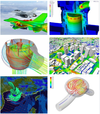
Massively-Parallel Computational Fluid Dynamics
Simon Cox, Stephen Turnock, Alexander Phillips (Investigators), James Hawkes
Computational Fluid Dynamics (CFD) is a numerical method for modelling fluid flows and heat transfer - and is used in many industries. It can be used to model dynamics around aircraft, ships and land vehicles; and also has uses in engine design, architecture, weather forecasting, medicine, computer-generated imagery (CGI) and much more. To harness the full power of CFD, it is necessary to utilise the full power of modern supercomputers. This project aims to improve the scalabilty of existing CFD codes so that more complex problems can be tackled efficiently.

Miscible multiphase systems with phase transition
Andrea Boghi
We aim to develop the computational model for the miscible displacement of liquid occupying a porous bulk, as, for instance, in the processes of vegetable solvent extraction, soil remediation or enhanced oil recovery. All these process includes the dissolution of solute and the displacement of solution from porous media. The focus of our current research work is, therefore, twofold: (i) to develop and verify a theoretical model for an evolving miscible displacement, by taking into account dynamic surface tension and mass diffusion through the interphase boundary, and (ii) to provide a model for the solute/solvent displacement from the porous volume.
Mixed FEM-particle method for nonlinear fluid-structure interaction problems, with applications to maritime engineering
Kamal Djidjeli (Investigator)
Simulating fluid-structure interaction problems involving large flow motions and deformations using particle methods.

Modelling power output and wake effects in tidal stream turbine arrays
William Batten (Investigator), Matthew Harrison, Luke Blunden
The PhD research is regards the investigation of modelling techniques for simplifying turbine simulation so that models of large arrays can be investigated.

Modelling the morphodynamic evolution of the Ganges-Brahmaputra-Meghna (GBM) Delta over centennial time scales
Stephen Darby (Investigator), Balaji Angamuthu
Around 0.5 Billion people live in deltaic environments where they are threatened by flooding and land loss frequently. Yet, our understanding of the threats posed by land dynamic process remains limited. In this work, we try to address this issue through a land dynamic simulation of the largest and most populated of all the deltas, the GBM Delta, using the CFD software Delft3D for a range of climate change and management scenarios. The results provide new insight into the factors controlling past morphodynamics that, in turn, are helpful when assessing the possible trajectories of future evolution.

Multi-objective design optimisation of coronary stents
Neil Bressloff, Georges Limbert (Investigators), Sanjay Pant
Stents are tubular type scaffolds that are deployed (using an inflatable balloon on a catheter), most commonly to recover the shape of narrowed (diseased) arterial segments. Despite the widespread clinical use of stents in cardiovascular intervention, the presence of such devices can cause adverse responses leading to fatality or to the need for further treatment. The most common unwanted responses of inflammation are in-stent restenosis and thrombosis. Such adverse biological responses in a stented artery are influenced by many factors, including the design of the stent. This project aims at using multi-objective optimisation techniques to find an optimum family of coronary stents which are more resistant to the processes of in-stent restenosis (IR) and stent thrombosis (ST).

Multiscale modelling of neutron star oceans
Ian Hawke (Investigator), Alice Harpole
Type I X-ray bursts are explosions which occur on the surface of some
neutron stars. It is believed that the burning begins in a localised spot in the ocean of the
star before spreading across the entire surface. By gaining a better understanding of X-ray
bursts, it is hoped that tighter limits can be determined for other neutron star properties
such as the radius and magnetic field strength.
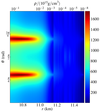
Numerical Elastic Neutron Stars
Ian Hawke, Ian Jones (Investigators), Andrew Penner
We study the astrophysical effects of the crust on a neutron star using an elasto-hydrodynamic model.

Numerical investigation of the true sources of jet noise
Anurag Agarwal (Investigator), Samuel Sinayoko
Aircraft noise severely impacts the quality of life of people living close to airports. Noise generation by aircrafts is especially large during take-off. Jet noise is the dominant noise source during take-off. It is produced by the high speed flow generated by the engine. However, the actual source of sound remains unknown. A deeper understanding of the sources of jet noise is need to be able to reduce the noise. The aim of this project is to implement a innovative method that would allow to identify the sources of jet noise.

Porous Media and Hydrothermal Circulation in Weakened Ocean Crust
Formation of oceanic crust is an interplay between magma and the cooling hydrothermal system above that its own heat drives. To understand this system we must understand where and how water circulates through the crust.
Ocean crust is riddled with faults and other permeable pathways along which water preferentially flows. We seek to use basic numerical models of circulation in porous media to understand how much of an influence on crust formation these anomalous features have, compared to the bulk, unfractured crust.

Prediction of Hydrodynamic Characteristics of Planing Hulls using CFD
Kamal Djidjeli (Investigator)
Performance prediction is an important part of vessel design. Common methods used for predicting planing hull performance include empirical equations and model tests. Model tests are usually expensive, while empirical equations are often applicable to similar hull types. In this work, CFD is used as an alternative prediction tool for high speed planing vessels.

Prediction of orifice flow flooding rates through generic orifices
Dominic Hudson, Ming-yi Tan (Investigators), Christian Wood, Adam Sobey
This presearch concentrates on the modelling of compartment flooding rates following the occurrence of damage in a ship's side shell. Typical state of the art flooding models use Torricelli’s formula to calculate flooding rates using a constant co-efficient of discharge (Cd). Based on Bernoulli’s theorem, turbulence and viscosity effects are not included using a Cd independent of damage shape or size. Previous work indicates that this assumption over-simplifies the problem to an extent where the flooding rates used for calculation are in error. This project will use CFD validated by experiment to calculate flooding rates for a large number of cases from which a 'krigged' response surface will be generated. Validity of the subsequent response surface will be interrogated.

Preventing Alzheimer's Disease: A Multiphysics Simulation Approach
Neil Bressloff, Giles Richardson, Roxana-Octavia Carare (Investigators), Alexandra Diem
Experimental research has identified the causes of many diseases, such as Alzheimer's Disease. However, finding an effective treatment is very cost- and time-intensive and sacrifices many animals and does not guarantee success. In this PhD project, we investigate the driving force of solute drainage in the brain using multiphysics simulations in order to identify possible ways of preventing dementia.

Real-time CFD for helicopter flight simulation
Kenji Takeda (Investigator), James Kenny
Project aims to show how real-time computational fluid dynamics (CFD) could be used to improve the realism of helicopter flight simulators.
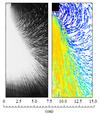
Simulations investigating droplet diameter-charge models, for predicting electrostatically atomized dielectric liquid spray chracteristics
Gabriel Amine-Eddine (Investigator)
Liquid sprays are atomized using electrostatic methods in many scienti fic, industrial and engineering applications. Due to jet and droplet breakup mechanisms, these spray plumes contain a range of drop diameters with differing droplet charge levels. Using an transient charged spray CFD code, simulations have been performed to investigate charge-diameter relationship models for predicting dynamics of poly-disperse and electrostatically atomized hydrocarbon sprays.
The methodology developed can be readily extended towards high-pressure spray applications, where secondary atomization plays a dominant role within the spray dynamics and subsequent performance of the spray itself.
Amine-Eddine, G. H. and Shrimpton, J. S. (2013), On simulations investigating droplet diameter–charge distributions in electrostatically atomized dielectric liquid sprays. Int. J. Numer. Meth. Fluids, 72: 1051–1075. doi:10.1002/fld.3776

Stochastic computational methods for aero-acoustics
Gwenael Gabard (Investigator), Martina Dieste
Stochastic methods are used to synthesize a turbulent flow which is then used to model the sound radiated by an airfoil interacting with this turbulence. This approach is faster than performing a complete simulation of the flow field.
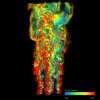
Stratified combustion physics and modelling
Edward Richardson (Investigator)
Full-resolution simulation data for turbulent combustion are used to investigate the fundamental impact, and practical modelling, of fuel-air stratification.

Study of global instability in separated flows at high Mach number
Neil Sandham, Zhiwei Hu (Investigators), Kangping Zhang
Flow instability is observed when extending two-dimensional (2D) stable flow into three-dimensional (3D). Development of instability varies along different spanwise length. Thresholds are also discovered for the flow studied to become instable.

Supersonic axisymmetric wakes
Richard Sandberg (Investigator)
Direct numerical simulations are used to shed more light on structure formation and evolution in supersonic wakes.

The effect of roughness upon turbulent supersonic flows
Neil Sandham (Investigator), Christopher Tyson
Understanding the interaction between surface roughness and supersonic air flows are crucial in the design of high speed vehicles, including space re-entry vehicles. Numerical simulations of these flows has been conducted in order to examine and understand how the surface roughness interacts with high speed flows in terms of drag prediction and heat transfer to the wall surface.

The Maximum Entropy Production Principle and Natural Convection
Seth Bullock, James Dyke (Investigators), Stuart Bartlett
In this project I wanted to perform some tests of the so-called Maximum Entropy Production Principle (MEPP) in the context of buoyancy-driven convection in a system with negative feedback boundary conditions.
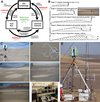
The Origin of Aeolian Dunes (TOAD)
Joanna Nield (Investigator)
The overall aim of this project is to understand the genesis and subsequent evolution of aeolian early stage bedforms by quantifying for the very first time the role and importance of flow, transport and surface feedbacks in the initiation and emergence of dunes. This project offers the genuine prospect of surmounting arguably the major enduring research question within aeolian geomorphology, leading to broader insights which will offer knowledge benefits for sedimentary landform studies as a whole.

The use of channel wings for slow speed UAV flight
Andy Keane (Investigator), Juraj Mihalik
In this project, advanced computational modeling and robust design optimization tools are used to observe the possibility of use of the Custer channel wings for slow speed UAV flights.

Towards biologically-inspired active-compliant-wing micro-air-vehicles
Richard Sandberg (Investigator), Sonia Serrano-Galiano
Despite a good knowledge of the physiology of bats and birds, engineering applications with active dynamic wing compliance capability are currently few and far between. Recent advances in development of electroactive materials together with high-fidelity numerical/experimental methods provide a foundation to develop biologically-inspired dynamically-active wings that can achieve "on-demand" aerodynamic performance. However this requires first to develop a thorough understanding of the dynamic coupling between the electro-mechanical structure of the membrane wing and its unsteady aerodynamics. In this collaborative initiative between the University of Southampton and Imperial College London, we are developing an integrated research programme that carries out high-fidelity experiments and computations to achieve a fundamental understanding of the dynamics of aero-electro-mechanical coupling in dynamically-actuated compliant wings. The goal is to utilise our understanding and devise control strategies that use integral actuation schemes to improve aerodynamic performance of membrane wings. The long-term goal of this project is to enable the use of soft robotics technology to build integrally-actuated wings for Micro Air Vehicles (MAV) that mimic the dynamic shape control capabilities of natural flyers.

Transition to turbulence in high-speed boundary layers
Neil Sandham (Investigator), Nicola De Tullio
This work is focused on the numerical simulation of hypersonic transition to turbulence in boundary layers. We use direct numerical simulations of the Navier-Stokes equations to analyse the effects of different flow conditions and external disturbances on the transition process. The main objective is to gain insight into the different aspects of transition to turbulence at high speeds, which can lead to the design of new transition models and transition control techniques for high-speed flows.

Turbulence and tidal turbines
William Batten (Investigator), Tom Blackmore, Luke Blunden
The PhD research is focused on understanding the effects of turbulence on tidal turbines. The problem has been simplified using grid generated turbulence and actuator disc representations of tidal turbines.

Unsteady Aerodynamics of Wings in Extreme Conditions
Charles Badoe (Investigator), Neil Sandham, Zheng-Tong Xie
Sizing of civil aircraft is dictated by extreme loads experienced at the limits of flight envelope, for example during gust, turbulence or low speed manoeuvre. The project aims to understand the unsteady aerodynamic behaviour of wings in extreme conditions involving heaving motions near stall.

Variability in high pressure blade trailing edge geometry and its impact on stage capacity and blade temperature
Andy Keane (Investigator), Jan Kamenik
My project involves the trailing edge (TE) geometry of gas turbine high pressure turbine blades, which is subject to inevitable variability due to the manufacturing processes involved.

Vertical turbulence structures in the benthic boundary layer as related to suspended sediments
Hachem Kassem (Investigator), Charlie Thompson
There is a genuine need for better, more robust modelling of suspended sediment transport in the coastal zone, both to understand its morphological evolution and it's impact on biogeochemical cycling, ecosystems services and to guide engineering applications such as dredging and defence schemes against erosion and flooding.
The suspension of sediment in turbulent flows is a complex case of fluid-particle interaction, governed by shear stresses (momentum exchanges) at the bed and within the benthic boundary layer (BBL). The intermittent transfer of momentum is a manifestation of coherent turbulent vortex structures within the flow. The passage of such structures (or clusters of) is often related to perturbations of bottom sediment, which may be entrained and maintained in suspension if sufficient turbulent energy is provided. The first part of my PhD investigated the temporal and scale relationships between wave–generated boundary layer turbulence and event–driven sediment transport in oscillatory flow in the nearshore. This involved complex statistical, spectral, quadrant and wavelet analysis of high frequency nearshore measurements of turbulence and suspended sediments (medium sand), collected as part of the EU-funded Barrier Dynamics Experiment II (BARDEX II). The following step aims to develop a 3D numerical model in OpenFOAM which would reproduce the fine scale turbulence structures observed over a fixed rippled bed in oscillatory flow. The 3D velocity field, turbulent components, correlations (stresses) and quadrant structures will then be linked to observed sediment resuspension events. The model will be validated against a set of laboratory experiments undertaken at the Fast Flow Facility at HR Wallingford.
Vortex Flow and it's influence on the aerodynamic design of a Front Wing of a Formula Student Car
Iteratively increasing complexity of front wing design, studying the effects of vortices.
Vortex Flow and it's influence on the aerodynamic design of a Front Wing of a Formula Student Car
Iteratively increasing complexity of front wing design, studying the effects of vortices.

Wave-based discontinuous Galerkin methods
Gwenael Gabard (Investigator), Greg Kennedy
Wave-based computational methods are developed to model sound propagation in moving inhomogeneous media.

Wind direction effects on urban flows
Zheng-Tong Xie, Ian Castro (Investigators), Jean Claus
Numerical simulations of turbulent air flow are conducted on Iridis to investigate the effects of different wind directions on the flow within and above an urban-like canopy.

Wind Turbine Blade Flow in Abnormal Environments
Zheng-Tong Xie (Investigator), Yusik Kim
Large wind turbines are being installed throughout UK and often in regions with complex meteorology and/or topography (e.g. involving wind gusts, turbulence, icing), which affect turbine performance (energy output, noise emission etc), life expectancy and safety. It is very expensive to conduct experiments to study such problems. This proposal suggests, firstly, an LES study of low-Re flows around an oscillating airfoil, to investigate the transition, separation, vortex shedding and dynamic stall behaviour. Secondly, a combined LES-RANS approach (with, e.g., a transitional RANS model in the near wall region) will be carefully designed (using our recently developed efficient turbulence generator at the interface between LES and RANS) and validated against low-Re results.
People
 Neil Bressloff
Neil BressloffProfessor, Engineering Sciences (FEE)
 Seth Bullock
Seth BullockProfessor, Electronics and Computer Science (FPAS)
 Geraldine Clough
Geraldine CloughProfessor, Medicine (FM)
 Simon Cox
Simon CoxProfessor, Engineering Sciences (FEE)
 Stephen Darby
Stephen DarbyProfessor, Geography (FSHS)
 Hans Fangohr
Hans FangohrProfessor, Engineering Sciences (FEE)
 Bharathram Ganapathisubramani
Bharathram GanapathisubramaniProfessor, Engineering Sciences (FEE)
 Carsten Gundlach
Carsten GundlachProfessor, Mathematics (FSHS)
 Andy Keane
Andy KeaneProfessor, Engineering Sciences (FEE)
 Richard Sandberg
Richard SandbergProfessor, Engineering Sciences (FEE)
 Neil Sandham
Neil SandhamProfessor, Engineering Sciences (FEE)
 Suleiman Sharkh
Suleiman SharkhProfessor, Engineering Sciences (FEE)
 John Shrimpton
John ShrimptonProfessor, Engineering Sciences (FEE)
 Pandeli Temarel
Pandeli TemarelProfessor, Civil Engineering & the Environment (FEE)
 Stephen Turnock
Stephen TurnockProfessor, Engineering Sciences (FEE)
 Zheng-Tong Xie
Zheng-Tong XieProfessor, Engineering Sciences (FEE)
 Nicolas Green
Nicolas GreenReader, Electronics and Computer Science (FPAS)
 Peter Horak
Peter HorakReader, Optoelectronics Research Centre
 Tobias Keller
Tobias KellerReader, Ocean & Earth Science (FNES)
 Giles Richardson
Giles RichardsonReader, Mathematics (FSHS)
 Tiina Roose
Tiina RooseReader, Engineering Sciences (FEE)
 Roxana-Octavia Carare
Roxana-Octavia CarareSenior Lecturer, Medicine (FM)
 Dominic Hudson
Dominic HudsonSenior Lecturer, Engineering Sciences (FEE)
 Edward Richardson
Edward RichardsonSenior Lecturer, Engineering Sciences (FEE)
 Zhi-Min Chen
Zhi-Min ChenLecturer, Chemistry (FNES)
 Kamal Djidjeli
Kamal DjidjeliLecturer, Engineering Sciences (FEE)
 James Dyke
James DykeLecturer, Electronics and Computer Science (FPAS)
 Gwenael Gabard
Gwenael GabardLecturer, Institute of Sound & Vibration Research (FEE)
 Ian Hawke
Ian HawkeLecturer, Mathematics (FSHS)
 Ian Jones
Ian JonesLecturer, Mathematics (FSHS)
 Georges Limbert
Georges LimbertLecturer, Engineering Sciences (FEE)
 Ming-yi Tan
Ming-yi TanLecturer, Engineering Sciences (FEE)
 Trevor Thomas
Trevor ThomasLecturer, Engineering Sciences (FEE)
 Anatoliy Vorobev
Anatoliy VorobevLecturer, Engineering Sciences (FEE)
 Rie Sugimoto
Rie SugimotoSenior Research Fellow, Institute of Sound & Vibration Research (FEE)
 Charlie Thompson
Charlie ThompsonSenior Research Fellow, Ocean & Earth Science (FNES)
 Felipe Alves Portela
Felipe Alves PortelaResearch Fellow, Engineering Sciences (FEE)
 Charles Badoe
Charles BadoeResearch Fellow, Civil Engineering & the Environment (FEE)
 William Batten
William BattenResearch Fellow, Civil Engineering & the Environment (FEE)
 Luke Blunden
Luke BlundenResearch Fellow, Civil Engineering & the Environment (FEE)
 Andrea Boghi
Andrea BoghiResearch Fellow, Engineering Sciences (FEE)
 Dario Carugo
Dario CarugoResearch Fellow, Engineering Sciences (FEE)
 Nicola De Tullio
Nicola De TullioResearch Fellow, Engineering Sciences (FEE)
 Aleksander Dubas
Aleksander DubasResearch Fellow, Engineering Sciences (FEE)
 Hachem Kassem
Hachem KassemResearch Fellow, Ocean & Earth Science (FNES)
 Heinrich Luedeke
Heinrich LuedekeResearch Fellow, Engineering Sciences (FEE)
 Roxana Aldea
Roxana AldeaPostgraduate Research Student, Mathematics (FSHS)
 Gabriel Amine-Eddine
Gabriel Amine-EddinePostgraduate Research Student, Engineering Sciences (FEE)
 Balaji Angamuthu
Balaji AngamuthuPostgraduate Research Student, Geography (FSHS)
 James Bailey
James BaileyPostgraduate Research Student, Engineering Sciences (FEE)
 Stuart Bartlett
Stuart BartlettPostgraduate Research Student, Electronics and Computer Science (FPAS)
 Patrick Bechlars
Patrick BechlarsPostgraduate Research Student, Engineering Sciences (FEE)
 Ioannis Begleris
Ioannis BeglerisPostgraduate Research Student, Engineering Sciences (FEE)
 Tom Blackmore
Tom BlackmorePostgraduate Research Student, Civil Engineering & the Environment (FEE)
 Leonidas Bourikas
Leonidas BourikasPostgraduate Research Student, Civil Engineering & the Environment (FEE)
 ThankGod E. Boye
ThankGod E. BoyePostgraduate Research Student, Engineering Sciences (FEE)
 Rory Brown
Rory BrownPostgraduate Research Student, Civil Engineering & the Environment (FEE)
 Jamie Caldwell
Jamie CaldwellPostgraduate Research Student, Engineering Sciences (FEE)
 Paul Chambers
Paul ChambersPostgraduate Research Student, Engineering Sciences (FEE)
 Jean Claus
Jean ClausPostgraduate Research Student, Engineering Sciences (FEE)
 Laura Cooper
Laura CooperPostgraduate Research Student, Engineering Sciences (FEE)
 Steven Daniels
Steven DanielsPostgraduate Research Student, Engineering Sciences (FEE)
 Nicola De Tullio
Nicola De TullioPostgraduate Research Student, Engineering Sciences (FEE)
 Alexandra Diem
Alexandra DiemPostgraduate Research Student, Engineering Sciences (FEE)
 Martina Dieste
Martina DiestePostgraduate Research Student, Institute of Sound & Vibration Research (FEE)
 Robert Entwistle
Robert EntwistlePostgraduate Research Student, Engineering Sciences (FEE)
 Stephanie Erickson
Stephanie EricksonPostgraduate Research Student, Mathematics (FSHS)
 Stephen Gow
Stephen GowPostgraduate Research Student, Engineering Sciences (FEE)
 Joshua Greenhalgh
Joshua GreenhalghPostgraduate Research Student, Engineering Sciences (FEE)
 Alice Harpole
Alice HarpolePostgraduate Research Student, Mathematics (FSHS)
 James Harrison
James HarrisonPostgraduate Research Student, Engineering Sciences (FEE)
 Matthew Harrison
Matthew HarrisonPostgraduate Research Student, Civil Engineering & the Environment (FEE)
 James Hawkes
James HawkesPostgraduate Research Student, Engineering Sciences (FEE)
 Alex James
Alex JamesPostgraduate Research Student, Institute of Sound & Vibration Research (FEE)
 Aditya Karnik
Aditya KarnikPostgraduate Research Student, Engineering Sciences (FEE)
 Greg Kennedy
Greg KennedyPostgraduate Research Student, Institute of Sound & Vibration Research (FEE)
 Puram Lakshmynarayanana
Puram LakshmynarayananaPostgraduate Research Student, Civil Engineering & the Environment (FEE)
 David Lusher
David LusherPostgraduate Research Student, Engineering Sciences (FEE)
 Nicholas McCaw
Nicholas McCawPostgraduate Research Student, Engineering Sciences (FEE)
 Juraj Mihalik
Juraj MihalikPostgraduate Research Student, Engineering Sciences (FEE)
 Sanjay Pant
Sanjay PantPostgraduate Research Student, Engineering Sciences (FEE)
 Alvaro Perez-Diaz
Alvaro Perez-DiazPostgraduate Research Student, Engineering Sciences (FEE)
 Lyuboslav Petrov
Lyuboslav PetrovPostgraduate Research Student, Electronics and Computer Science (FPAS)
 Richard Pichler
Richard PichlerPostgraduate Research Student, Civil Engineering & the Environment (FEE)
 Daniel Powell
Daniel PowellPostgraduate Research Student, Engineering Sciences (FEE)
 Stephen Powell
Stephen PowellPostgraduate Research Student, Engineering Sciences (FEE)
 Craig Rafter
Craig RafterPostgraduate Research Student, Engineering Sciences (FEE)
 Hossam Ragheb
Hossam RaghebPostgraduate Research Student, Engineering Sciences (FEE)
 Watchapon Rojanaratanangkule
Watchapon RojanaratanangkulePostgraduate Research Student, Engineering Sciences (FEE)
 Álvaro Ruiz-Serrano
Álvaro Ruiz-SerranoPostgraduate Research Student, Chemistry (FNES)
 Stefan C. Schlanderer
Stefan C. SchlandererPostgraduate Research Student, Engineering Sciences (FEE)
 Kieran Selvon
Kieran SelvonPostgraduate Research Student, Engineering Sciences (FEE)
 Sonia Serrano-Galiano
Sonia Serrano-GalianoPostgraduate Research Student, Engineering Sciences (FEE)
 Ashley Setter
Ashley SetterPostgraduate Research Student, Engineering Sciences (FEE)
 Adam Sobey
Adam SobeyPostgraduate Research Student, Engineering Sciences (FEE)
 Stefano Spagnolo
Stefano SpagnoloPostgraduate Research Student, Engineering Sciences (FEE)
 Daniele Trimarchi
Daniele TrimarchiPostgraduate Research Student, Engineering Sciences (FEE)
 Jacob Turner
Jacob TurnerPostgraduate Research Student, Engineering Sciences (FEE)
 Christopher Tyson
Christopher TysonPostgraduate Research Student, Engineering Sciences (FEE)
 James Underwood
James UnderwoodPostgraduate Research Student, Engineering Sciences (FEE)
 Koen van Mierlo
Koen van MierloPostgraduate Research Student, Engineering Sciences (FEE)
 Valerio Vitale
Valerio VitalePostgraduate Research Student, Electronics and Computer Science (FPAS)
 Jonathon Waters
Jonathon WatersPostgraduate Research Student, Engineering Sciences (FEE)
 Thorsten Wittemeier
Thorsten WittemeierPostgraduate Research Student, Engineering Sciences (FEE)
 Ruilin Xie
Ruilin XiePostgraduate Research Student, Engineering Sciences (FEE)
 Emanuele Zappia
Emanuele ZappiaPostgraduate Research Student, Engineering Sciences (FEE)
 Kangping Zhang
Kangping ZhangPostgraduate Research Student, Engineering Sciences (FEE)
 Petrina Butler
Petrina ButlerAdministrative Staff, Research and Innovation Services
 Susanne Ufermann Fangohr
Susanne Ufermann FangohrAdministrative Staff, Civil Engineering & the Environment (FEE)
 Erika Quaranta
Erika QuarantaEnterprise staff, Engineering Sciences (FEE)
 Alexander Wright
Alexander WrightEnterprise staff, Engineering Sciences (FEE)
 Anurag Agarwal
Anurag AgarwalAlumnus, Institute of Sound & Vibration Research (FEE)
 Li-Wei Chen
Li-Wei ChenAlumnus, Osney Thermo-Fluids Laboratory, Oxford University
 Manuel Diaz Brito
Manuel Diaz BritoAlumnus, Pall Corporation
 Jan Kamenik
Jan KamenikAlumnus, University of Southampton
 Kondwani Kanjere
Kondwani KanjereAlumnus, Engineering Sciences (FEE)
 James Kenny
James KennyAlumnus, Engineering Sciences (FEE)
 John Muddle
John MuddleAlumnus, Mathematics (FSHS)
 Andrew Penner
Andrew PennerAlumnus, Mathematics (FSHS)
 Samuel Sinayoko
Samuel SinayokoAlumnus, BMLL
 Kenji Takeda
Kenji TakedaAlumnus, Engineering Sciences (FEE)
 Ahsan Thaivalappil Abdul Hameed
Ahsan Thaivalappil Abdul HameedAlumnus, University of Southampton
 Moresh Wankhede
Moresh WankhedeAlumnus, Dacolt International B.V.
 Christian Wood
Christian WoodAlumnus, Engineering Sciences (FEE)
 Mark Vousden
Mark VousdenExternal Member, University of Southampton
 Venkata Boppana
Venkata BoppanaNone, None
 Ian Castro
Ian CastroNone, None
 Zhiwei Hu
Zhiwei HuNone, None
 Satya Jammy
Satya JammyNone, None
 Yusik Kim
Yusik KimNone, None
 John Leggett
John LeggettNone, None
 Alexander Phillips
Alexander PhillipsNone, None
 Daisuke Sasaki
Daisuke SasakiNone, None
 Markus Weinmann
Markus WeinmannNone, None